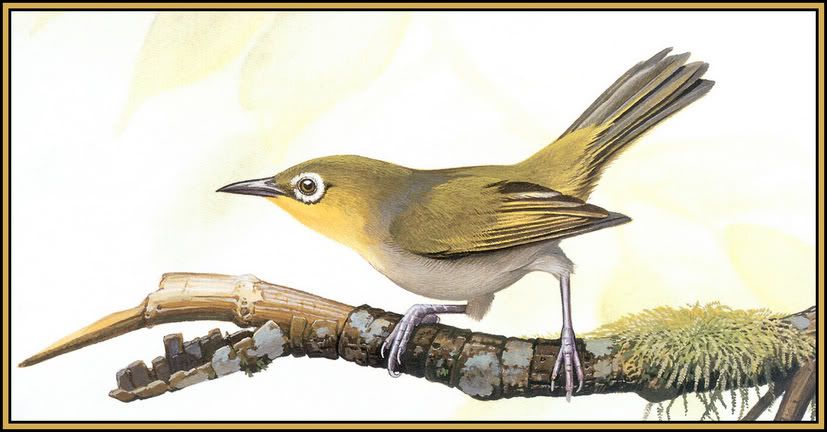|
|
Post by Melanie on May 31, 2005 1:27:09 GMT
Zosterops strenuus was endemic to lowland forests on Lord Howe Island, Australia. It was common before 1918, but plummeted to extinction following the arrival of black rat Rattus rattus on the island in that year, and could not be found in 1928. Painting  |
|
|
|
Post by another specialist on Jun 10, 2005 4:23:26 GMT
 The smaller bird is the familiar Silvereye Zosterops lateralis of mainland Australia. The larger bird is the Robust Silvereye Zosterops strenuus, which formerly lived only on Lord Howe Island.After rats arrived on the island in 1915 following a ship wreck, this unique species was exterminated within three years. www.amonline.net.au/birds/collections/uses01.htm |
|
|
|
Post by another specialist on Jun 13, 2005 8:42:02 GMT
TAXON SUMMARY Robust White-eye 1 Family Zosteropidae 2 Scientific Name Zosterops strenuus Gould, 1855 3 Common Name Robust White-eye 4 Conservation status Extinct 5 Reasons for listing This subspecies was last seen 1918. 6 Infraspecific taxa None described, although this species is sometimes considered to be a subspecies of Z. tenuirostris along with Z. t. tenuirostris of Norfolk I. (Schodde and Mason, 1999). 7 Past range and abundance The Robust White-eye was endemic to Lord Howe I. (Mathews, 1929). It was formerly numerous, but rapidly declined after 1918 (Hindwood, 1940). It could not be found in 1928 (Sharland, 1929) and has not been recorded since. 8 Ecology The Robust White-eye occurred in lowland forest areas (Hindwood, 1940). 9 Reasons for extinction Predation by Black Rats Rattus rattus, introduced accidentally in 1918 after a shipwreck, are the mostly likely cause of extinction (Hindwood, 1940). www.deh.gov.au/biodiversity/threatened/action/birds2000/pubs/rob-white-eye.pdf |
|
|
|
Post by another specialist on Nov 6, 2005 20:07:24 GMT
 gap in nature |
|
|
|
Post by Carlos on Jun 10, 2006 14:11:37 GMT
In Fuller (2002) Extinct Birds (Foreword - HBW7) Robust White-eye Zosterops strenuusZosterops strenua Gould, 1855
Proc. Zool. Soc. London 1855: 166The species was endemic to the island of Lord Howe, a tiny piece of land, 11 km long by 1.6 wide, that lies far out in the Tasman Sea between Australia and New Zealand. During the mid-nineteenth century, when the bird was firs identified, it was found to be common, and the population stayed healthy for the next 60 years or so. Then in 1918, an incident occurred that proved fatal for many or the birds of Lord Howe. A ship, the SS Makambo, was accidentally grounded at a site known as Ned's Beach. Black rats ( Rattus rattus) left the stricken vessel an poured ashore - and the consequences were disastrous. In a very short space of time the white-eyes gone. A search made just ten years later could find no trace of them. There are a few records concerning the habits of the species. When it was common it was regarded as something of a pest. It was destructive to fruit and crops, and was even said to suck the eggs of other bird species! Its own eggs were laid during November and December. They were blue and, typically, the clutch consisted of two or three. The nest was cup-shaped and made from rootlets and grasses with a soft lining of disintegrated leaves and other suitable materials. Curiously, another kind of white-eye lived on tiny Lord Howe. this was a race of the widespread Silvereye ( Zosterops lateralis), and to distinguish the larger birds belonging to the species Z. strenuus local people gave them the name "big grinnels". |
|
|
|
Post by Carlos on Aug 15, 2007 10:56:00 GMT
Lord Howe White-eye Zosterops tenuirostris strenuus Gould, 1855 RMNH 110.011: Lord Howe Island. RMNH 110.012: adult. Lord Howe Island, August — September 1887. Exchanged with museum Sydney in 1900. Exterminated by rats and owls The inhabitants of Lord Howe, a small island 600 km east of Australia, were very particular about rats. Already more than a hundred years ago they realized that rats could destroy the natural balance of the island. Therefore ships were never allowed ashore, but had to drop anchor off the coast. Small boats were used to ship the cargo. In spite of these precautions, disaster struck in June 1918. The SS Makambo drifted ashore and rats invaded the island. Within years various endemic birds of Lord Howe became extinct. In order to exterminate the rats owls were introduced, but these only added to the disaster. The owls not only hunted the rats, but also killed many of the endemic birds, including the Lord Howe Thrush and the Lord Howe White-eye. The Lord Howe Thrush built its nest on the ground, which made it particularly vulnerable for rats. A survey in 1913-14, before the rat invasion, showed it to be common. The white-eye was even abundant at that time and was considered a pest by the local fruit farmers. Within ten years after the disaster with the Makambo, both species had vanished, as had the Lord Howe Starling Aplonis fusca (Gould, 1836). Museum specimens Museum specimens of the Lord Howe Thrush and Lord Howe White-eye are rare. They can be found in Tring (United Kingdom), Berlin, New York, Washington and Sydney. The thrush in the Leiden Museum, a female, was part of the C.J. Temminck's private collection and dates from the late 18th or early 19th century. One of the two skins of the white-eye was donated by the Sydney Museum at about 1900. The provenance of the other specimen is unknown. ip30.eti.uva.nl/naturalis/detail.php?lang=uk&id=19[This page has links to see 3D images of the two Leiden specimens in high resolution] |
|
|
|
Post by Melanie on Mar 8, 2015 21:03:24 GMT
|
|